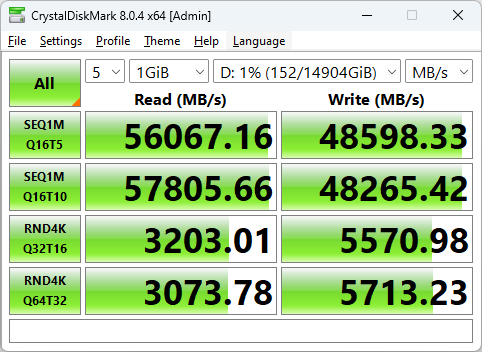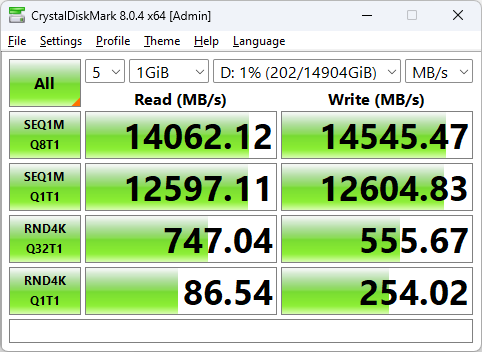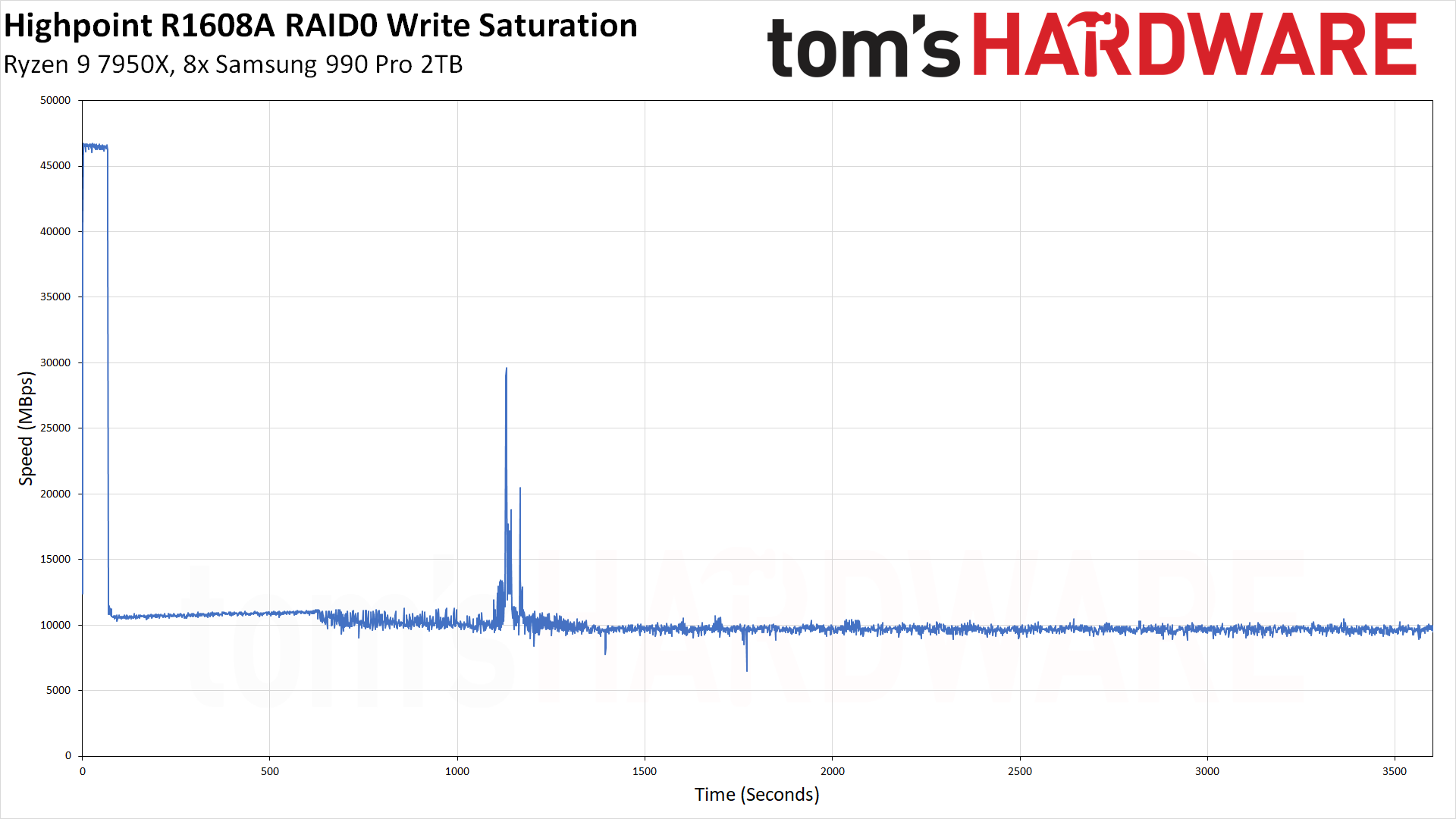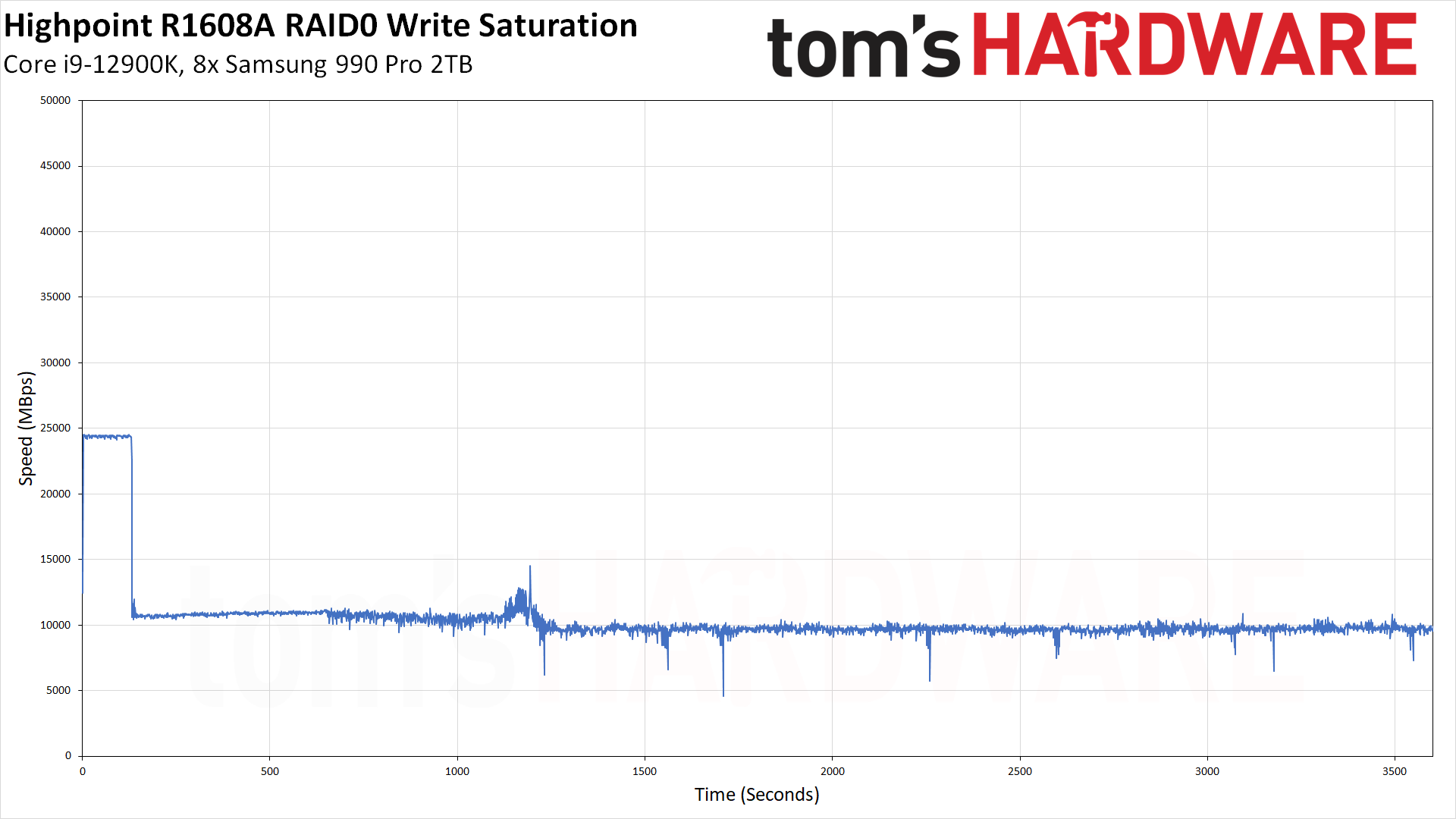Why you’re able to trust Tom’s HardwareOur expert reviewers spend hours testing and comparing products and services so you can choose the best for you.Find out more about how we test.
HighPoint Rocket Performance Results
We haven’t tested a RAID adapter in quite some time, certainly not with our current SSD test rig. What’s more, the HighPoint Rocket 1608A doesn’t function ideally in our regular platform, and HighPoint recommends using AMD systems (or at least not the Z790 board that we have). As such, it doesn’t make sense to compare performance of the 1608A with regular SSDs.We did run our normal test suite, just for kicks, but most of the results are unremarkable — DiskBench, PCMark 10, and 3DMark don’t hit the higher queue depths necessary to let the hardware shine. In fact, in some cases the use of software RAID0 can even reduce performance for the lighter storage workloads that we normally run.To that end, we’ve elected to run a more limited set of tests that can push the hardware to its limits. If you just want an adapter that allows the use of eight M.2 SSDs, whether with RAID or not, the 1608A can also provide that functionality, but it’s a rather expensive AIC for such purposes.
Synthetic Testing — CrystalDiskMark
CrystalDiskMark (CDM) is a free and easy-to-use storage benchmarking tool that SSD vendors commonly use to assign performance specifications to their products. It gives us insight into how each device handles different file sizes and at different queue depths.
We were able to hit HighPoint’s speed of 56 GB/s with reads at the recommended queue depth of 80, with a sequential benchmark at Q16T5. This seems to be a relative limit of the hardware — we’re using PCIe 4.0 SSDs — as even a fuller array achieved a similar performance level. Sequential writes tapped out lower, as expected, at just over 48 GB/s. You may be able to get more performance out of the hardware with faster SSDs than the 990 Pro.Running an even higher queue depth may also help and, in general, a high queue depth is required to fully make use of the Rocket 1608A. Newer, faster PCIe 5.0 drives, especially with a count in excess of four, should be able to achieve better performance than we’re showing here.This goes for smaller I/O like the coveted 4KB, as well. With a queue depth of 512 — Q32T16 — the array achieved up to 3.2 GB/s for random 4KB reads and, with queue depth of 2048 — Q64T32 — random 4KB writes reached almost 5.7 GB/s. Performance at QD1 sees no real improvement, as expected. Performance here could be improved with a smaller stripe size and 4Kn formatting, but a high queue depth will be needed with your workload to make it worthwhile. On the other hand, if you’re going for pure bandwidth then a larger I/O size is the way to go, but you will never quite hit the theoretical maximum of the interface for reads or writes.The number of drives in use can also be relevant for performance and the desired workload. Being able to evenly balance the workload ofnnumber of drives is a good goal, which could see improvement with annmultiple queue depth workload. With PCIe 4.0 drives, all eight will be pushed to the maximum to make up for the lower individual drive bandwidth. Four PCIe 5.0 drives may not necessarily have the same IOPS horsepower as that configuration, but using more than that many drives results in severely diminishing returns. Uneven drives — using different models or capacities — may also throw off performance results.

Sustained Write Performance and Cache Recovery
Official write specifications are only part of the performance picture. Most SSDs implement a write cache, which is a fast area of (usually) pseudo-SLC programmed flash that absorbs incoming data. Sustained write speeds can suffer tremendously once the workload spills outside of the cache and into the “native” TLC or QLC flash.We used Iometer to hammer the HighPoint R1608A with sequential writes for two hours, which shows the size of the write cache and performance after the cache is saturated.
One reason you might want such an expensive array is if youreallywant insanely high sustained performance. These are consumer SSDs, so we’re still dealing with pSLC caching. With our eight PCIe 4.0 990 Pros this does mean it’s possible to outrun the cache as normal, with sustained pSLC writes up to 45 GB/s or so with TLC dropping to maybe a quarter of this speed. That’s not super amazing but it’s certainly possible to get more.When using eight PCIe 5.0 drives, especially ones like theSabrent Rocket 5with high TLC speeds, sustained performance will be much higher. Additionally, you get the combined cache size of the drives but write speeds are capped after four or so of these drives so the pSLC mode will effectively last longer. As a result, sustained write performance could be quite high in relative terms. That said, performance of this sort requires specific workloads, with high queue depth still being beneficial, so plan accordingly.We know from ourSamsung 990 Pro 2TB reviewthat each SSD can provide up to ~6.2 GB/s of write performance for around 40 seconds, after which the drive drops down to a steady state write throughput of around 1.4 GB/s. Multiply that by eight and we get a theoretical 59.6 GB/s of burst performance followed by a theoretical 11.2 GB/s of steady state throughput, so the Rocket 1608A doesn’t quite hit that maximum throughput.This is where using newer, faster drives could potentially help. TheCrucial T705as an example has initial burst performance of 12 GB/s for writes, and most of the Phison E26-based SSDs should be able to max out the x16 link and reach around 56 GB/s. Then performance drops to around 4 GB/s, plus there’s a folding state of around 1.25 GB/s that lasted for four minutes in our testing before returning to 4 GB/s. We don’t have eight identical PCIe 5.0 drives for testing, but in theory such SSDs could offer steady state performance closer to 25–30 GB/s rather than the 10 GB/s we’re seeing with the Samsung 990 Pro.Note also how peak throughput plummeted when we tested the HighPoint Rocket 1608A in our regular Intel Z790 test PC. Where the AMD X670E board allowed 46.5 GB/s of burst performance, the Z790 board peaked at just 24.4 GB/s. This is a known issue with certain Intel motherboards, so if you’re after maximum thoughput you’ll again want to look at AMD offerings or Intel Xeon platforms.

Test Bench and Testing Notes
While our SSD testing normally uses an Alder Lake platform, for these tests we switched to an AMD Zen 4 system. We disable most background applications such as indexing, Windows updates, and anti-virus disabled in the OS to reduce run-to-run variability.Most users building a high-end PC that might benefit from an AIC like the HighPoint Rocket 1608A will also want to have a graphics card, and that presents a problem on mainstream PCs. Only the primary x16 slot provides a full 16 lanes of PCIe 5.0 connectivity, and if you populate a secondary x16 slot, you’ll either get PCIe 4.0 speeds or the main slot will get bifurcated into x8/x8 or x8/x4/x4.That’s why HEDT platforms that have more than 24 lanes of PCIe 5.0 connectivity are recommended for cards like the Rocket 1608A. you may still potentially get up to PCIe 5.0 x8 speeds of 32 GB/s, much faster than any single M.2 slot, but in that case you may not even want to bother with a more expensive PCIe 5.0 compatible AIC.
HighPoint Rocket Bottom Line
The HighPoint Rocket 1608A is an amazingly fast storage solution when configured with the right drives and the right platform. It’s flexible enough to be used less efficiently, depending on your hardware, but requires a significant investment to reach its full potential. Many of the Rocket 1608A’s features will be overkill for home use and only make sense in an enterprise setting. The power draw alone means planning ahead. That said, it’s impossible to deny the high performance levels that are possible, if your workload has sufficient queue depth.In CrystalDiskMark, we reached over 56 GB/s. That sounds like a lot, but we’ve seen this 56 GB/s number achieved before with the Apex X16Rocket 5Destroyer, which is based on a different switch and can use up to 16 downstream SSDs. In that case, the switch is a Switchtec PM50084 from Microchip, which can address more lanes but fundamentally is still limited to 16 PCIe 5.0 upstream lanes in this type of AIC configuration. That’s certainly overkill and, while the PM50084 is even more featureful than the Rocket 1608A’s Broadcom-based solution, the latter makes more sense for HEDT use.The price of $1,499 sounds like a lot until you look back and price high-end 8TB consumer NVMe SSDs: the Rocket 1608A can be paired with multiple smaller, less expensive drives and achieve outstanding performance, without the drawbacks of QLC NAND or higher cost 8TB drives. The eightSamsung 990 Pro 2TBSSDs we tested combined only cost around $1,360, less than the AIC itself. But we were only testing the card; we suspect most people and companies planning to use such an adapter will be more interested in populating the card with eight 4TB drives.Adding just one drive to a system with an adapter is no big deal. Adding more can bring frustration, as many of the AICs on the market require motherboard PCIe bifurcation support. This, among other things, usually precludes the use of a discrete GPU. It’s possible to get a slower PCIe switch with up to four drives, but if you need PCIe 4.0 or 5.0 performance from the drives and want up to eight drives — plus the option of up to 64 GB/s bandwidth upstream — then the Rocket 1608A makes a lot of sense. At least, if you’re looking at M.2 SSDs and do not require the full suite of management features and software. HighPoint has different SKUs for more serious projects.The Rocket 1608A isn’t for everyone but its presence in HighPoint’s lineup means that PCIe 5.0 storage is starting to mature. More efficient drives that will work in laptops, based on Phison’sE31T controller, were shown off atComputex, as were drives based on non-Phison controllers that can push PCIe 5.0 bandwidth. Even without them, fast 4.0 drives can be assembled to get the full upstream bandwidth out of the Rocket 1608A. For enthusiasts who want to add more M.2 drives or enjoy high-performance storage on their servers, more options are coming to the market, and even the relatively limited Rocket 1608A is a powerful addition in its own right — especially with faster platforms becoming the norm.
MORE:Best External SSDs
Current page:HighPoint Rocket Performance Results
Shane Downing is a Freelance Reviewer for Tom’s Hardware US, covering consumer storage hardware.



